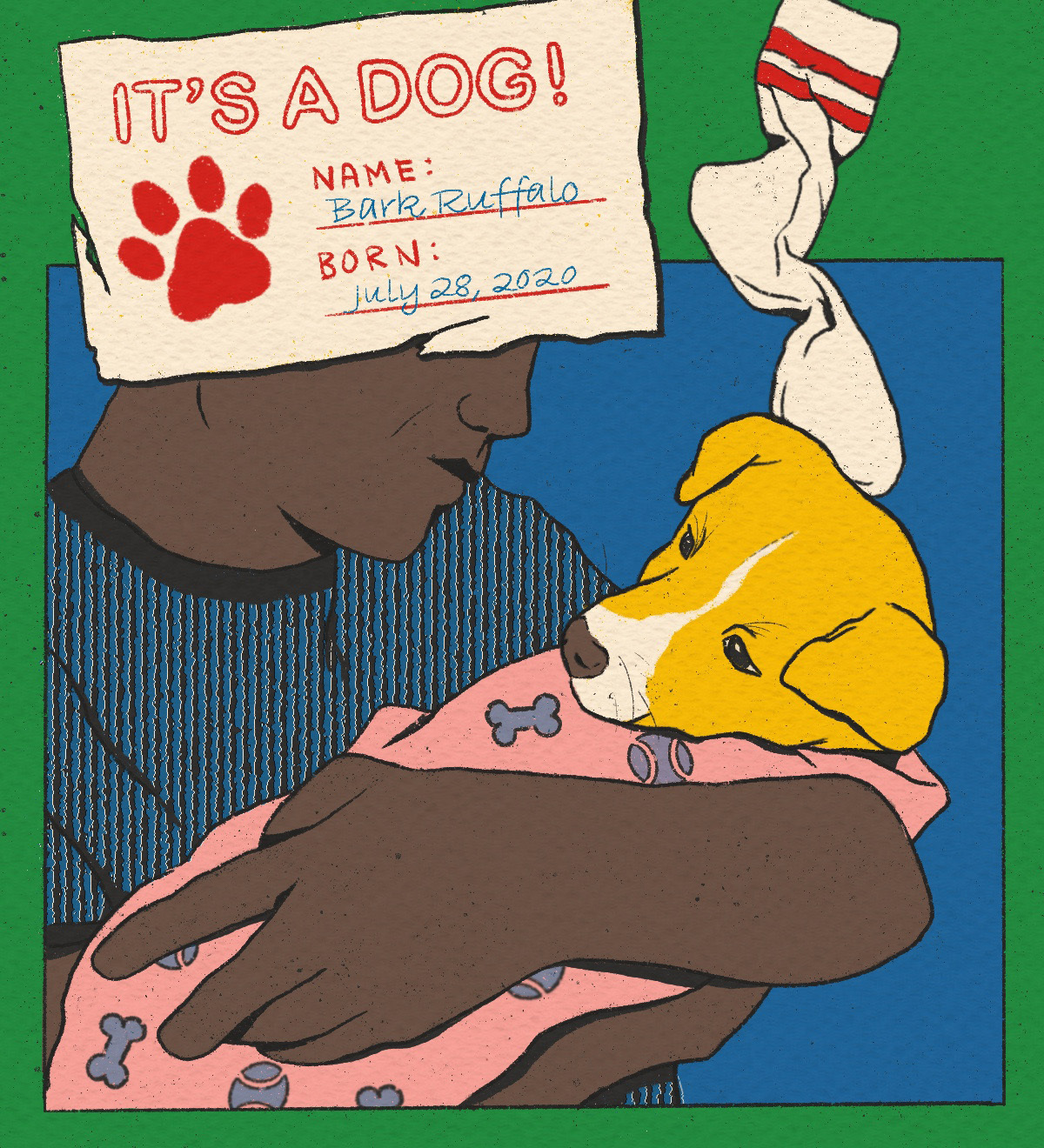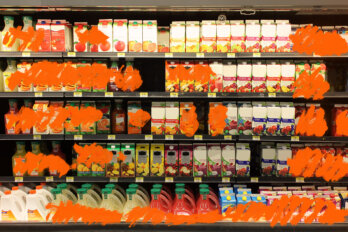I n April 2022, four months after my wife and I brought our puppy home, I took the most expensive walk of my life.
Early spring thaws had begun to melt the snow that blanketed my small town in southern Ontario, allowing all the detritus of winter to slowly come free. Jace—a cross between standard poodle and Australian Shepherd—was excited by the new sights, new smells. But especially by the garbage. Entranced by all the paper and plastic and indeterminate mounds that typically emerge from former snow banks, he seemed to have decided early on that each of the items was a toy carefully set aside for his enjoyment.
It happened faster than I could react. He spied a particularly appetizing, child-sized sock, left for some reason on the grass by the side of the park. It was in his mouth in seconds. I realized I was doomed before I could even close the gap between us, tugging as hard as I could on the leash. Jace, not yet fully trained, had not broken the habit of resource guarding anything he could fit in his jaw (and many things he could not). He made a low growl in the back of his throat and, as I contemplated a bloody battle over the fabric, did something I didn’t expect. He cocked his head back, eyes gleaming with puppy triumph, and swallowed.
It was a Saturday afternoon, so our local, small-town vet wasn’t open. It took me a little under an hour to call the closest after-hours clinic, shove the dog in the back seat, and drive to a neighbouring city. They saw him right away, which was lucky, because it meant the emergency care clinic could induce vomiting. He threw up the sock, and after I waited in the car for some monitoring, we headed home in short order. The vet’s bill for that evening’s walk? Two hundred and eighty-seven dollars.
It could have been a lot worse, as anyone with a dog will know. But the whole thing did make me wonder if I myself had been the one to bite off more than I could chew. I’d always loved dogs but never considered how much effort went into taking care of them, and once the hard realities began to set in, I asked myself more and more often why exactly we’d signed up for this. Dogs, I was beginning to learn, love unconditionally. As long as you meet their conditions. And my memory of those first months is a blurry montage of gnashing teeth and playful barks and an endless, inexhaustible drive to run.
My wife and I are far from alone in bringing a new pet into our lives during the chaos of the pandemic. An Abacus Data study in June 2021 estimated that 3 percent of Canadians—or about 900,000 people—became first-time pet owners between the start of the pandemic and June 2021, while a national study by Pet Valu, published in February 2022, estimated 3 million pets had joined Canadian homes since COVID-19 hit. And while now, more than a year later, I’ve come to realize I don’t regret our decision to get a dog, not all new pet owners arrived at the same conclusion. Humane societies and the Society for the Prevention of Cruelty to Animals (SPCAs), drained of dogs during the peak of the pandemic by the massive demand for adoption, are full to bursting after many families, overwhelmed or facing financial pressures, subsequently surrendered their pets. Supply chain issues have caused pet food shortages and rising costs across Canada and the US, while the veterinary industry’s looming labour crisis has finally come to an acute head. There’s no question that the pandemic changed the already booming pet industry, but can the systems that support it handle the load?
B y many estimates, my generation is now the most dog-obsessed cohort on earth. Recent numbers see millennials outstripping even the baby boomers in pet ownership. For some, this might be because having a pet is less expensive than having children. For years, some young people—burdened by a lack of finances compared to previous generations, or perhaps just more inclined to own pets—have been happy with that arrangement. It’s also true that record-low interest rates during the pandemic kept borrowing costs down, which made the cost of a pet more palatable to some fence-sitting households. But the most obvious factor is easy to understand: pets are the antithesis of loneliness, and many people turned to dog ownership at a time marked by that feeling.
For some, that’s been an opportunity. Hani Auran, who co-founded Woof Pack—a subscription box service for dogs—in 2017, saw his business more than double from around 8,000 subscribers in its first year to more than 20,000 today. In January 2021, he, alongside his business partner, launched a line of toys, producing more elaborately themed boxes for a market flooded with new pet owners. My wife and I have been subscribers for months, and our dog has received monthly packages for “Dogsgiving” and arcade night, complete with a plastic “wooftendo” chew toy shaped vaguely like the iconic, three-pronged N64 controllers of my own childhood. And yes, it has occurred to us that our dog is spoiled.
Woof Pack is only a part of a wave of boutique pet businesses that target the droves of new owners eager to ensure their own pets are doted upon equally. Dog owners of today can purchase everything from apparel for their pets to elaborate, custom portraits. Larger retailers have seen similar growth. Pet Valu, which has over 700 stores today, added around eighty since the start of 2020, plus an additional sixty-six with its acquisition of Chico, Quebec’s largest pet specialty franchise, in February 2022. Its second quarter earnings report in 2022 stated that system-wide sales had increased by 75 percent since 2019.
But despite soaring revenues for pet businesses, it’s become more expensive to own a pet. And that cost is a rising concern in an unstable economy. Supply chain issues during the pandemic saw the price of pet food spike as ingredients became more costly. In June 2021, the US-based PetFood Institute reported an estimated increase of between 8 and 20 percent in the cost across all ingredients, a problem which continued into 2022. My own dog food bill often exceeds $100 a month—far higher than what we’d expected. And though we’re fortunate to be in a position to afford it, not every family is as lucky. Some humane societies and other bodies have begun to organize more pet food banks, which proliferated during the pandemic. Add the cost of vet care or training into the equation and the math is simple: dogs are expensive. And it’s an expense that not every household can continue to afford.
Last May, the Kingston Humane Society reported a record number of dogs in its care, with sixty-two in the shelter and over 100 in foster care. Calgary has also seen a spike in calls to surrender dogs. In PEI, where many residents have struggled to find affordable, pet-friendly housing, humane societies have set grim records for the number of animals surrendered. And while the intake/outcome data at humane societies across the country remained largely static throughout much of 2022, the length of the animals’ stays has increased. There are many factors contributing to this, according to Barbara Cartwright, the CEO of Humane Canada, an organization that represents fifty-five humane societies and SPCAs across the country, but she points out that one of the largest has been puppy mills. The pandemic pet boom also saw an increase in less reputable pet breeding, and many animals being surrendered today struggle with health or behavioural issues that stem from poor conditions in these mills. This can prolong the time a dog spends in a shelter before it’s ready to be adopted.
But perhaps the greatest challenge, affecting both pet owners and shelters alike, is access to veterinary care. Last June, the Canadian Veterinary Medical Association (CVMA), an organization that works with vets across Canada, hosted a congress to address the national workforce shortage. According to Louis Kwantes, former president of the CVMA, this shortage poses a critical problem for the profession.
There were concerns even prior to the pandemic. In 2019, the CVMA commissioned a national workforce study and found that, given projected rises in pet (especially dog) ownership and a roughly 3 percent annual attrition rate, the veterinary industry would need to increase its workforce by about 3.5 to 4 percent per year in order to keep up—a pace that has only been accelerated by the pandemic.
Many vets who were approaching retirement age chose to retire early during the pandemic, putting the extra pressures of doing the job in the COVID era—from curbside care to personal health risks—on younger vets trying to remain in the industry. As a result, the mental health of staff, Kwantes says, has also become a major concern.
This workforce shortage hasn’t affected everyone evenly. Rural areas have traditionally attracted fewer vets than urban ones, and in some parts of eastern Canada, for example, you might have to drive for hours to get emergency care for your animal. Small animal clinics across the country have had to shut down emergency services temporarily because of staffing issues, and Kwantes says he’s aware of at least one emergency clinic having to close for a period of time. And while many of us may be able to overlook these problems, “if it’s your pet that needs emergency care, and you can’t get it, that’s huge,” he says.
The shortage means that some pet owners are more likely to be referred to costly after-hours clinics, like I was when my dog swallowed that sock. And it will likely result in rising costs across the board, putting further financial pressure on some families and already struggling shelters.
Some solutions are in the works. In April 2022, the BC provincial government committed to doubling the number of subsidized seats at the Western College of Veterinary Medicine, from twenty to forty, with an investment of over $10 million. Meanwhile, some humane societies and SPCAs are working to provide resources, from education to pet food banks, to their communities in an effort to keep pets with their families.
And though it has been met with some controversy, the Canadian Food Inspection Agency has banned importing dogs from around 100 countries with a high risk of rabies. International dogs entering the country at a slower pace could relieve some of the pressure on both vets and humane societies—though, of course, there are many ways for prospective owners to acquire dogs domestically.
But with the early days of the pandemic behind us—along with the outpouring of initial support for shelters—Cartwright notes that now, more than ever, they need help to maintain the social safety net that has until recently remained in place.
For so many of us, pets fill in the gaps when our worlds seem to crack and splinter. We yearn for companionship and, sometimes, for something soft and warm to cuddle. But that crucial role in our lives doesn’t always come easily. For me, it meant an expense of time and energy as a tireless puppy ruled my life. Yet others sacrifice a lot more to make sure anyone who wants it can experience having a pet and that their new companions are cared for.
Today, the systems that have held up Canadian pet owners and their animals are stretched to the breaking point. And if things don’t change, that same salve for society’s ills may be unavailable to many households in the future. When we most needed them, in the darkest days of the pandemic, dogs were there for us. Now, the simple truth is that they need us too.





